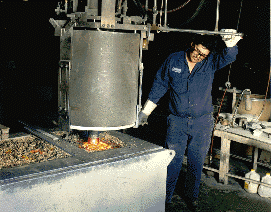Vacuum Die Casting
The vacuum casting process was originated and developed by Aurora Metals Division over 45 years ago for casting of high strength, corrosion resistant aluminum bronzes. Over the years it has proven to be an economical answer to many difficult parts problems. Because of the inherent qualities realized, combining precision near net shape and strength, vacuum die casting is used to produce parts formerly made of steel that required a significant amount of secondary machining.
Vacuum die casting! Here’s how it works:
A steel die is enclosed in an airtight bell housing. The housing or receiver has two openings: the sprue, at the bottom, through which molten metal enters the die and the vacuum outlet at the top. The sprue opening is submerged below the surface of the molten metal and the vacuum is drawn within the receiver, creating a pressure differential between the die cavity and the molten metal in the crucible. This pressure differential causes the molten metal to flow up the sprue and into the die cavity, where it solidifies. The die is removed from the receiver, opened, and the casting ejected. The cycle is then repeated with each shot producing from one to several castings, depending on the number of cavities in the die.


By controlling the vacuum, the pressure differential between the die cavity and the molten metal can be varied allowing for differential fill rates necessitated by part design and gating requirements. This results in tight control of the fill rate which also directly influences the soundness of the casting. Through proper part design, die design and the use of the vacuum die process, voids, shrinks, and gas pockets can be greatly reduced or eliminated in critical areas.
Because the sprue opening is submerged beneath the surface of the molten metal, only pure alloy, free from oxides and dross, can enter the die cavity. This helps to produce clean, sound castings with minimal foreign materials that detract from strength, appearance and machinability.
